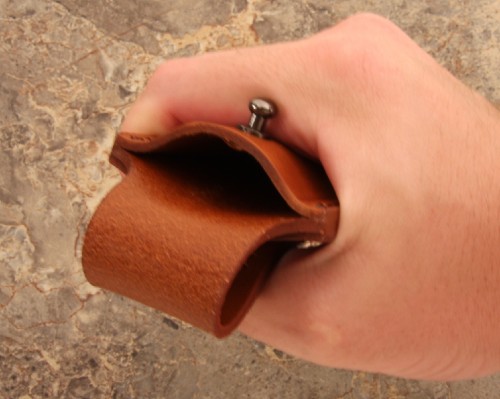When & How to Take Care of Your Leather Sheaths
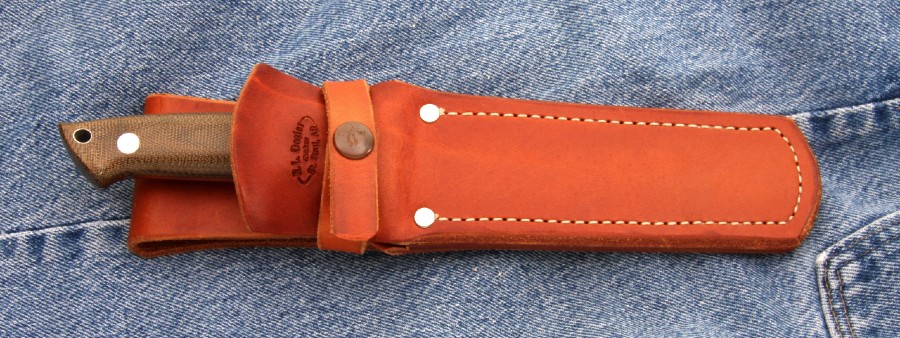
Leather has been used as a sheath material for centuries - it looks great, it’s relatively easy to work with, and it is fairly durable. Even though it is a great material, leather still requires some care and maintenance if you want it to really last. Neglect your leather sheath and it might dry out, crack, grow mildew, or react with nearby metals and cause corrosion.
Regular maintenance and a little attention to proper storage will prevent this.
What You Need To Know About Leather Care
Leather is cured animal skin, and you can learn how to take care of it by thinking about it like skin.
-
Don’t let leather stay wet for long periods.
-
Don’t let its natural oils dry out from excessive heat - like on your hot dashboard, or near a campfire or furnace.
-
If you wouldn’t put a product on your own skin, don’t put it on your leather.
-
Don’t holster a dirty, wet, or bloody knife.
-
Don’t over-condition it. Too many processes, too much oil, wax, harsh cleanings, and chemicals can wear your leather out, overly soften it, or overly harden it.
Brand New Leather Sheaths
If you’ve bought a new leather sheath, wipe it down and break it in.
Is It Stiff?
If your new sheath is stiff, or the leather snap doesn’t quite reach, just take a little time and work it out like you would a new pair of hiking boots.
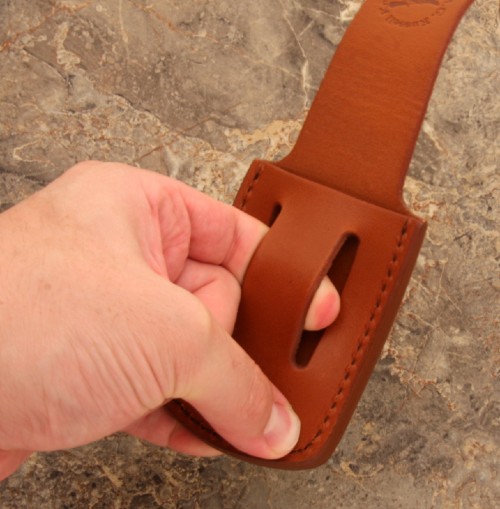
Makers purposefully make leather sheaths and pouches very tight - even too tight, because over time leather will stretch, and makers want your leather to be secure after it has been broken in.
Work the leather with your hands, and bend it around in the places you want the sheath to have movement and flexibility. A little bit of mild stretching won’t harm it.
In the picture I am stretching out a tight belt loop.
Leather Storage
DO NOT STORE YOUR KNIFE INSIDE YOUR LEATHER SHEATH. I cannot emphasize this enough. Leather attracts water and encourages rust and corrosion on your knives and hardware. It's fine when it's on your hip, but for storage, keep them separate, especially if it is a valuable knife. We store our blades in a cardboard sheath and rubber band them to the leather sheath.
Store your leather in a cool, dry place. The humidity should hopefully somewhere between 30% and 60%. Dehumidifers and silicon packets are great for reducing humidity.
How Often Do I Need To Condition My Sheath?
The type of leather, tanning process, original treatment, how often you use it, and the surrounding environment will all play a role in how often leather needs to be treated. A typical sheath in a moderate climate with moderate use will be fine if you take care of it once a year or so - and may not even need that much attention. If you live somewhere really dry like Arizona, or somewhere wet like the tropics or coasts, your leather may need a little more care.
If you want to play it safe though, check it every 6-12 months - especially sheaths you use often or any high dollar collectable handmade knives.
Over Conditioning Your Leather
Some folks take maintenance to an extreme level - if you put too much leather product/conditioner on your leather, or do it too often, you are going to wear it out or overly soften it. Unless something specific happens to it, it really doesn’t need anything more than once every 6-12 months. In fact many factory made sheaths and pouches are highly treated and may only need conditioning every 5-10 years if ever (think Buck 110 pouch for example).
 Leather Maintenance
Leather Maintenance
The first step in leather maintenance, just like in blade maintenance, is to clean it up.
Cleaning Your Leather
Most of the time, all you need is a quick wipe down with a soft, lightly damp cloth.
It is good to occasionally do a deeper cleaning to help lift out dirt and grime. You can use a good leather furniture cleaner or you can use saddle soap. Always try the cleaning product in an inconspicuous part as it may discolor your leather.
Note - if you use your blade for food, make sure that whatever you use on your sheath is also food safe.
I Got Blood Inside My Sheath / How Do I Clean The Inside?
Let me re-emphasize, never put away a dirty blade. Bring an extra rag, napkins, or even a plastic bag and clean your knife when you get home rather than sheath a dirty blade. It’s easier to clean your pant leg than it is to clean inside your sheath.
If it is too late and the inside needs cleaning, use a toothbrush and clean the inside with some warm soapy water, or saddle soap. If a toothbrush won’t fit, try making a J-hook out of a pipe cleaner, or use a soft bristle rifle bore brush. Make sure to allow your sheath to dry thoroughly before replacing the blade.
Moldy
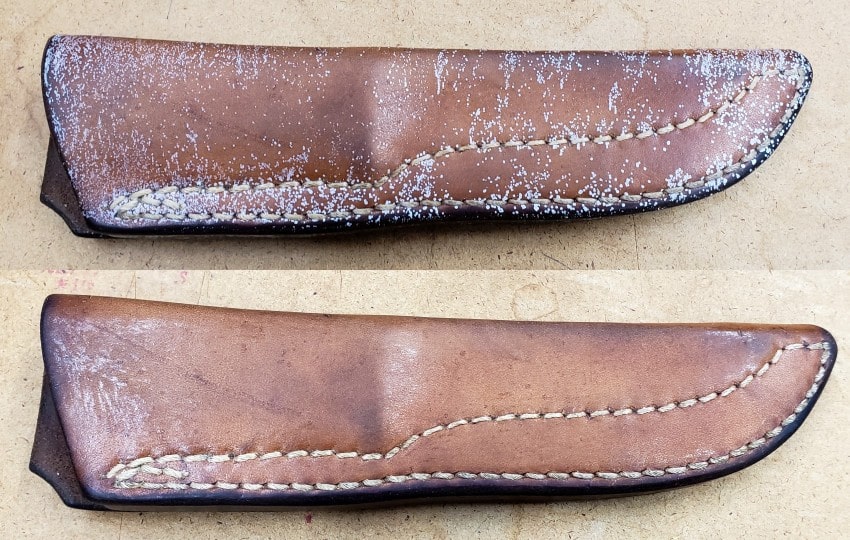
If your leather is smelly or moldy you can do a 1:1 ratio of water and white vinegar. Use a clean cloth, dip it in your vinegar solution, and then wring it out. The key is damp, not wet. Go over the leather a section at a time. It may need several applications over time to kill the bacteria. After it’s cleaned to your satisfaction, use a conditioner, as vinegar may dry out your leather.
For particularly stubborn mold we have used and suggest Mold Cleaner by Leather Master. For the pictured sheath above we escalated to several applications of Mold Cleaner. Once the mold was dead, we carefully scraped the mold matter off with a wooden toothpick. Finally we applied some conditioner which slightly darkened the leather (any other coloration differences is the lighting of the picture). We also cleaned up the corrosion on the hardware, which is explained below.
Cleaning up Leather Sheath Hardware - Verdigris - the Green Gunky Stuff
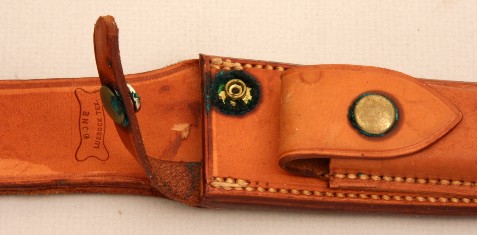 In a few cases, certain leathers (and tanning processes) tend to promote chemical reactions and corrosion with hardware, especially brass (depending on the makeup of the brass), and over time this green corrosion starts growing over the hardware. It is called Verdigris.
In a few cases, certain leathers (and tanning processes) tend to promote chemical reactions and corrosion with hardware, especially brass (depending on the makeup of the brass), and over time this green corrosion starts growing over the hardware. It is called Verdigris.
Here is how to remove verdigris, with the assumption that the sheath you are working on is very valuable.
If the corrosion is really bad, as shown in this picture, you’ll need to remove as much of it manually as possible. For valuable and antique sheaths I use toothpicks and Q-tips. If you accidentally mash some of the corrosion into your leather or the stitching, it’s not coming out easily.
After that, carefully clean the hardware up with some polishing paste. Clean the leather around it with a 50/50 water and white vinegar mix.
There’s not much you can do to prevent this other than keep it clean and wax the hardware / leather. I recommend Renaissance Wax.
If you have a Verdigris stain in the leather itself, try these steps:
Step 1 - First - remove as much of the verdigris as possible, lifting it away from the leather. The more you can physically lift off and remove the better. I used toothpicks and Q-tips. Try to not let any verdigris get on the leather as you remove it from the hardware.
Step 2 - In a small bowl, create a paste of baking soda and white vinegar and stir it until it’s the consistency of ketchup. This will help neutralize the corrosion.
Step 3 - Gently apply the paste with an old toothbrush, scrubbing gently. Baking soda is a light abrasive, so if your leather is brittle, or has a light sheen, this is going to lightly damage and scratch your leather. Keep that in mind. Work the paste into the leather’s pores where the stain is and let the paste sit for several minutes.
Step 4 - Gently clean the area with a clean, damp cotton cloth. You may need to repeat Step 3.
Alternative Solution - Another solution is to use equal parts lemon juice and salt. Scrub mildly, and wipe the lemon juice off right away rather than letting it sit as it may bleach the leather. Salt can also be a mild abrasive so keep that in mind as it may mark your leather.
Storage
Leather can encourage corrosion and rust on your knife, so when you put it in storage make sure to store your knife separately from your sheath. We like to put the knife in a cardboard sheath and then rubberband that to the leather sheath. Keep the knife guard (or any other metal) from touching the leather as well.
Conditioning Your Leather
 After you’ve cleaned up your leather, you can revitalize it with natural oils, and maybe preserve it with wax. Natural oils will bring some suppleness back to your leather and prevent cracking.
After you’ve cleaned up your leather, you can revitalize it with natural oils, and maybe preserve it with wax. Natural oils will bring some suppleness back to your leather and prevent cracking.
Always Read the Label & Follow Instructions
It’s amazing how often instructions are ignored, but read the label. Follow the instructions.
Some products include petroleum based ingredients, read the label and be sure they don’t. Petroleum based ingredients are included as a convenience to help the product dry faster, but they are best avoided because over time their structure breaks down which dries out your leather.
Which Leather Conditioner Should I Use?
After you have cleaned your sheath, you are ready to condition it. What leather conditioner/oil should you use? There are a lot of options, and I give brief opinions on several of them at the end of this article. Most leather conditioners will work fine. Avoid anything with petroleum based ingredients and avoid car leather products - those tend to be geared towards pleather (plastic leather or faux leather) rather than real leather. Use a conditioner made for real leather made with natural oils.
Applying Condition General Procedure
Follow the instructions on the product label - but if the instructions are sparse here are few good pointers.
-
Apply some conditioner to a clean cloth. Do not put too much on. You can always add more as you go.
-
Start in an inconspicuous place. Put a little on at a time, and rub it into the leather gently and thoroughly. Use circular motions. Get as far inside your sheath as you can reach. Let the conditioner sit there for a few minutes before wiping away the excess.
-
Take a second clean cloth and wipe it all down and clean off all excess product. Let your leather sit and dry overnight.
Wax & Waterproofing
Wax and products with wax as a base ingredient will help protect your leather sheath and its contents from the elements. Wax is NOT a necessary step in leather maintenance, but it can be useful in very dry or very wet conditions. It will help keep the natural oils in the leather from being leached out, and help waterproof your leather from wet environments. Apply wax or waterproofing products after conditioning your leather. Waxed / waterproofed leather will no longer breathe, so waxing is not always recommended.
Protecting Antique / Valuable Leather Sheaths
After using a leather conditioner, you can apply a light coat of KIWI’s Neutral Shoe Polish, or alternatively a light coat of Renaissance Wax. These products will help protect your leather from the elements from UV to some degree. If you have lights shining on the leather, apply every 6 months. These products are also great on ivory, bone, and stone handles. Do not use them on stag handles - it is too porous & it discolors them.
Hydrating Old Dried Out Leather
If your leather is dried out and starting to crack, it is past time to do some conditioning on it. Do not soak your leather in water. You will need a product to condition the leather and try to bring it back to life and restore the natural oils inside the leather. Some damage may be irreparable. Mink oil or Neatsfoot oil are excellent solutions to reconditioning old leather.
Hydration Steps:
-
Take a slightly damp cloth and carefully wipe the leather down, removing dust and dirt
-
Make sure your product is room temperature, or a little warmer.
-
Heat the mink oil and use a cloth or sponge to dab into the oil and rub the leather gently. Do it one section at a time until the whole piece is covered with oil.
-
Wipe off the excess, let it dry overnight, repeat if necessary.
-
Once you have it restored, seal in the oils with a preservative product made with natural wax (beeswax, etc.).
Note: Using Mink or Neatsfoot oil repeatedly will soften your leather. Too many applications (or too much product) and your sheath will start to lose shape.
Drying Out Wet Leather
If your leather gets soaked, do not dry out your leather too fast. Do not put it directly next to a campfire or a furnace. Fires and furnaces will dry out all the natural oils inside the leather and ruin it.
If your sheath is soaked, wrap your sheath in a dry towel and put it in a warm place, like out in the sun or a warm room. You may need to change the towel a couple of times. Do not set it directly in the sun. Do not put your blade back in the sheath while it is still wet.
Leather Care Products
Products To Avoid
-
Shoe Polish - Don’t use it. The vast majority of them will soften your leather and your sheath will lose its shape. Don’t use a brush that was used to apply shoe polish either. Shoe polish will also rub off on your clothes while wearing your sheath. Exception - KIWI Neutral Shoe Polish.
-
Petroleum based products - Big NO. These molecules will eventually break down and then dry out your leather. Manufacturers use petroleum based ingredients to help the product dry faster for your convenience, but the damage they do is rather inconvenient.
Popular Leather Care Products:
I wanted to take a moment and talk about some different types and options for leather. There are a lot of great compound products from great companies that do a fantastic job, but as you can read lots of reviews on those I will focus on the more pure and natural options.
Note that some products will darken your leather, keep this in mind if you want to preserve the coloring and try it out on an inconspicuous spot first. I prefer to use products that mention they are neutral in coloring. These are not ranked in any order.
Natural Options
Tallow - Obtained by boiling animal fat, scraping off the top, and using the tallow underneath. Tallow can work well as a preservative for leather and has been used for centuries (fun fact - it is also used for making soap). Some cautions - if made incorrectly or used too liberally, tallow can make your leather sticky, or it might go rancid. Sometimes it makes your leather attractive to animals for eating.
Olive Oil - Similar to tallow, olive oil is an excellent natural preservative. Used to excess, olive oil can get sticky or go rancid.
Neatsfoot Oil - Boiled Neatsfoot oil can bring your leather back to life. It will add the important natural oils back into your cracked leather. Use this only when your leather is very dried out. It will significantly soften your leather. If used to excess your leather will become too soft and may lose its shape. Leatherworkers use neatsfoot oil as they are making the leather and forming it to shape, they will give it a quick coat of neatsfoot oil to help it last, make it a little more supple, and give it a nice color.
Lanolin - A natural waxy secretion from sheep, it is an ingredient contained in many leather care products. Lanolin will soften your leather so do not go overboard.
Beeswax - Beeswax is an excellent preservative choice. Hydrate your leather with a conditioner, then apply beeswax to your leather. Heat the beeswax slightly, and work it in one section at a time - just like you have to work in hand lotion into your skin. Then wipe off the remainder. Beeswax will help waterproof your leather, but will also remove its ability to breathe.
Compound Products
These products can be found with natural ingredients or other compounds/chemicals, but are often a mix of several things to achieve the best results.
Saddle Soap - Very popular, saddle soap does an excellent job of cleaning. Some saddle soaps will only clean your leather, others may protect and condition your leather in addition to cleaning - it just depends on the product. Some Saddle Soaps will soften your leather, so be sure to read the label.
KIWI Neutral Shoe Polish - Popular product for protecting leather without discoloring it. It also works great for bone and ivory handles. Simply put a little on two fingers and gently work it in. Use on ivory handles 2 times a year.
Renaissance Wax - great for preserving valuable and historical sheaths. Often used by museums.
Ray Holes Saddle Butter - great for conditioning leather. Highly recommended by leatherworker, saddler, and holster maker John Costanza.
There are a lot of popular leather products out there such as Obenauf’s and Pecards. SnoSeal is popular for waterproofing your sheath. Find one that meets your needs, take a look at the reviews, and always be sure to read the instructions and product details in full.
Thanks for reading! Note - we didn’t receive anything to endorse any of the recommended products.
Published September, 2021
By Jake Broce with contributions from A.G. Russell III, Bob Dozier, John Constanza, and advice from several others.
Bonus Videos
Tips for working with New Leather from talking with Bob Dozier and John Constanza
Neatsfoot Oil - Use just enough to color it - great for forming new leather (or bringing really old leather back). Generally not recommended for general use as it really softens the leather.
Oxalic Acid - used to clean new natural leather that hasn’t been oiled yet. Original made as a wood bleach.
Bob Makes a Leather Sheath
Questions from Viewers:
Q. What solvent is used in the bottle where the brush is stored? That sure beats going through acid brushes by the dozen.
Answer: Bob uses Barge's Cement glue for the leather. He buys only the yellow and red can in 1 qt quantity at a time.
For brushes he gets soldering brushes and cuts the bristles short.
Then he gets a long thin jar (as seen in the video), like an olive jar, and keeps his brush in that. Inside that jar he puts some Barge's thinner. That's what keeps his brush clean. He says ALWAYS put the lid on the jar. Knocking that jar over with thick glue at the bottom is awful.

